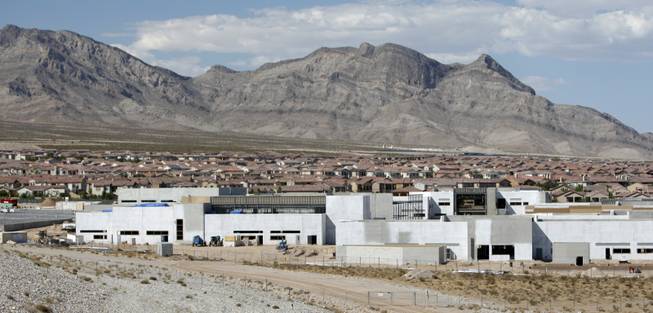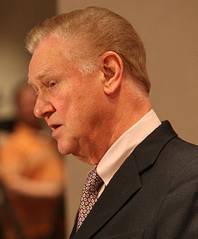
Construction continues on the West Career & Technical Academy at West Charleston Boulevard near Interstate 215. Despite stalled enrollment, the School District continues to build for its future.
Sunday, Sept. 13, 2009 | 2 a.m.

Walt Rulffes
Sun Archives
Sun Coverage
Beyond the Sun
For the better part of 10 years, the Clark County School District was breaking ground on a new school every month to keep pace with demand.
But enrollment growth appears to have stalled — and maybe for the first time in at least 25 years, there will be fewer students on campuses this fall than the previous year.
The numbers reflect the implosion of the Southern Nevada economy, and signal a gloomy possibility for the School District: If enrollment doesn’t rebound by next fall, there will be less money from the state.
On the upside, with the construction industry moribund in Clark County, the district thinks it can save money these days repairing older facilities, compared with prices paid during the boom years. With fewer students, the district can also save money on staffing.
However, fewer students means less money from the state to improve programs.
With growth braking to a stop, the district is bracing for the windfall as well as the fallout.
Official enrollment numbers will be taken Friday and used by the Nevada Education Department to determine per-pupil funding, which this year is $6,433. As of last week, the district had 308,567 students, 2,673 fewer than at this time last year.
A last-minute surge of students is unlikely but not impossible.
Two calendar events typically affect early enrollment numbers. Many school districts nationwide start school after Labor Day — which fell later than usual this year — and some Clark County parents are confused by the actual start date or choose to ignore it in favor of prolonging family vacations. The district also typically sees an increase in Hispanic students after Wednesday’s Mexican Independence Day.
District planners, anticipating an enrollment flatline, conservatively staffed schools this year at 97 percent of the projected enrollment, to reduce the likelihood of layoffs. (The district has reached 98 percent of the projected enrollment of 313,688 students.)
The district also boosted its reserve operating fund to cover the budget in the event that more students are enrolled after the state has paid up.
In the event of an enrollment decline, school districts are allowed to claim the same number of students they had in the previous academic year.
Before 2007, school districts were allowed to continue claiming the higher enrollment number for up to two years after a decline. But lawmakers tightened the provision, protecting school district budgets for just one year if the enrollment decline is less than 5 percent. It’s too early to predict next year’s enrollment, but Clark County officials say unfilled vacancies and larger classes — the results of budget cuts and cautious staffing — are likely to persist for the immediate future.
Last year enrollment declined at 13 of Nevada’s 17 public school districts.
From 2002 through 2006, enrollment grew by an average of 4 percent annually, turning Clark County into the nation’s fifth-largest school district. But 2007 brought just a 2 percent enrollment increase, half as many new students as officials had predicted.
In 2008 enrollment grew by just under 1 percent, the smallest percentage increase since 1983. A similar percentage had been expected for this year. But as the economic forecast darkened, district officials scaled back their expectations.
“Everyone’s saying the economy is improving, but it’s going to be a while before the schools see it,” Superintendent Walt Rulffes said. “If you look around at the empty storefronts and the empty airport, it’s hard to believe we’re going to be in a growth mode anytime soon.”
The trend frustrates educators who count on growth to fund an expansion of programs.
At Liberty High School, where enrollment is nearly 200 fewer than expected, Principal Rosalind Gibson said more students would have meant more funding for staff and more choices in core academics and electives. The school, which is about 30 percent under capacity, lost several teachers and its popular wood shop last year, when its enrollment came in below projection.
But there are upsides to slower enrollment growth, district officials say. More elementary schools can switch to nine-month calendars from the year-round schedules that are often less popular with families.
However, district officials say there’s still need for four new elementary schools and a new career and technical high school, currently scheduled to open in August 2010. The new schools, to be built with the remaining money from the 1998 bond measure, will serve areas where growth is still occurring and campuses are crowded.
But some district watchdogs say it would be better to put new schools on hold and make use of the tens of thousands of open seats throughout the Las Vegas Valley.
Rulffes disagrees.
Because of the slowdown in the construction market, the price of building a school has come down. Additionally, there is federal stimulus money available to supplant district bond money for construction. And, Rulffes said, putting more students on buses isn’t a solution parents would accept.
“We want community schools where people live,” Rulffes said.
Instead of mothballing new schools, Rulffes said it would be more likely the district would close or consolidate several older campuses while major repairs are under way.
The district opened six new schools this fall with about 7,500 desks. But many of those vacancies are intentional. The Veterans Tribute Career & Technical Academy opened with freshmen and sophomores, with empty seats for the junior and senior classes, which will be added in the next two years.
There are upsides to slower growth. School attendance zone boundaries will likely stabilize, meaning fewer students will be reassigned time and time again to different campuses. The district will also have more time to focus on instructional programs and professional development.
But fewer students can also mean smaller schools that are less cost-effective to operate.
On the other hand, the district can take a break from building new schools and repair older ones — at a time when it thinks it can demand reduced prices from contractors. The district has about $500 million in renovation and repair work in the pipeline.
During the boom years, the district often struggled to find qualified bidders to take on some of the more mundane — and less lucrative — work, such as replacing a campus’ heating system. A new school building in rural Sandy Valley was actually redesigned as a wood-frame structure after the district failed to find concrete supplier for a reasonable price.
At Thursday’s School Board meeting, architect Ken Small urged the members to put off approving paying between $82,000 and $89,300 to have construction consultants double-check the work of contractors and subcontractors at four school sites under construction.
Similar jobs are going for $50,000 in the private sector, Small said.
“Write in a 15 percent discount today,” Small said. “Say, ‘We’re sorry, funding is down. You can do the job for $15,000 less.’ ”
Paul Gerner, the district’s associate superintendent of facilities, told the School Board the work at campus sites is more complex than what the consultants are being asked to do on the private sector jobs, and he believes the price is fair. School Board members eventually approved the deals, but not before urging Gerner to take a closer look at all existing deals as opportunities for savings.
The district is paying the same price for the inspection consultants that it was two years ago, noted School Board Vice President Carolyn Edwards.
“It’s our duty to put some pressure on and get a better price,” Edwards said. “Times are different. The prices of our schools have dropped. If people want the work, we ought to be doing what we can to get the best price.”


Join the Discussion:
Check this out for a full explanation of our conversion to the LiveFyre commenting system and instructions on how to sign up for an account.
Full comments policy